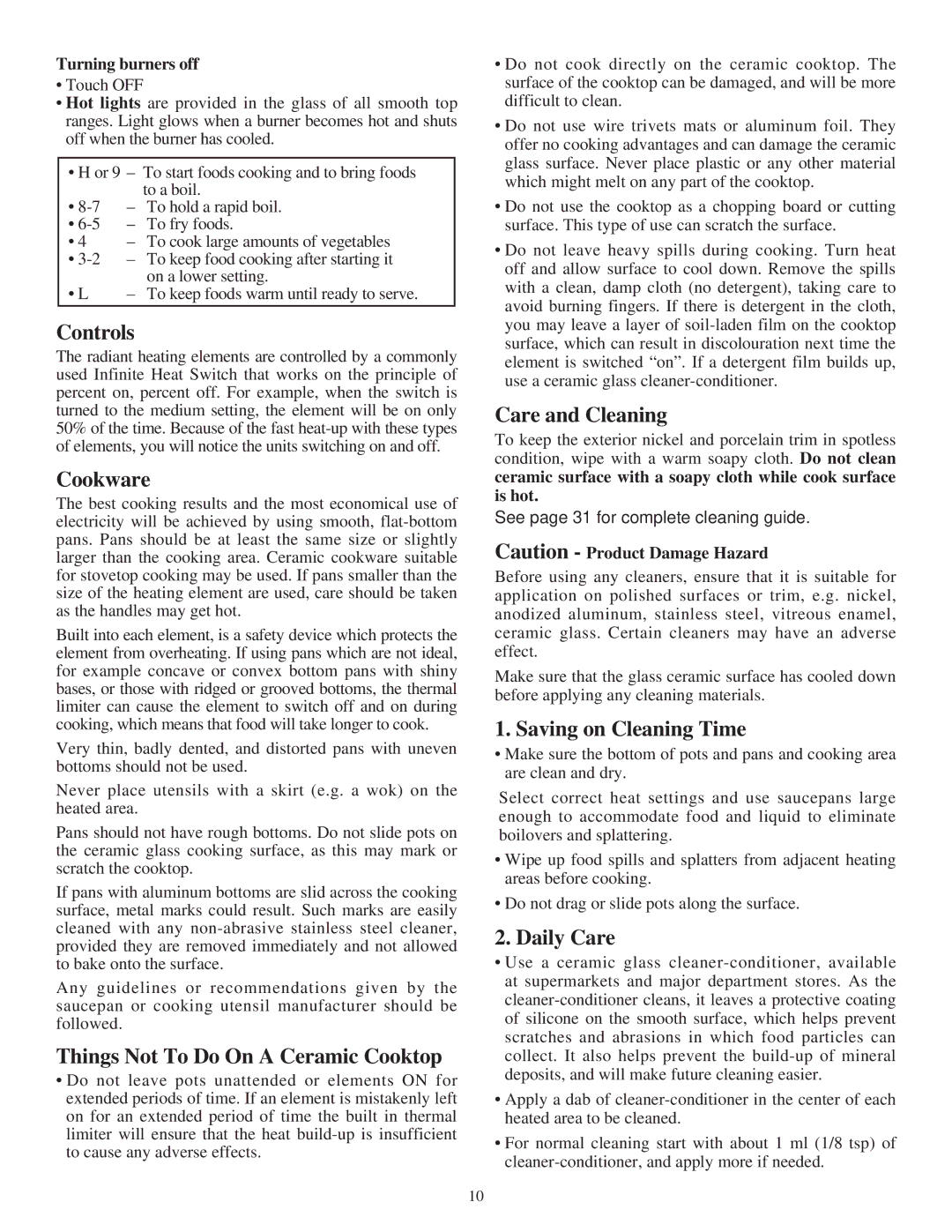
Turning burners off
•Touch OFF
•Hot lights are provided in the glass of all smooth top ranges. Light glows when a burner becomes hot and shuts off when the burner has cooled.
•H or 9 – To start foods cooking and to bring foods to a boil.
• | – To hold a rapid boil. |
• | – To fry foods. |
• 4 | – To cook large amounts of vegetables |
• | – To keep food cooking after starting it |
| on a lower setting. |
• L | – To keep foods warm until ready to serve. |
Controls
The radiant heating elements are controlled by a commonly used Infinite Heat Switch that works on the principle of percent on, percent off. For example, when the switch is turned to the medium setting, the element will be on only 50% of the time. Because of the fast
Cookware
The best cooking results and the most economical use of electricity will be achieved by using smooth,
Built into each element, is a safety device which protects the element from overheating. If using pans which are not ideal, for example concave or convex bottom pans with shiny bases, or those with ridged or grooved bottoms, the thermal limiter can cause the element to switch off and on during cooking, which means that food will take longer to cook.
Very thin, badly dented, and distorted pans with uneven bottoms should not be used.
Never place utensils with a skirt (e.g. a wok) on the heated area.
Pans should not have rough bottoms. Do not slide pots on the ceramic glass cooking surface, as this may mark or scratch the cooktop.
If pans with aluminum bottoms are slid across the cooking surface, metal marks could result. Such marks are easily cleaned with any
Any guidelines or recommendations given by the saucepan or cooking utensil manufacturer should be followed.
Things Not To Do On A Ceramic Cooktop
•Do not leave pots unattended or elements ON for extended periods of time. If an element is mistakenly left on for an extended period of time the built in thermal limiter will ensure that the heat
•Do not cook directly on the ceramic cooktop. The surface of the cooktop can be damaged, and will be more difficult to clean.
•Do not use wire trivets mats or aluminum foil. They offer no cooking advantages and can damage the ceramic glass surface. Never place plastic or any other material which might melt on any part of the cooktop.
•Do not use the cooktop as a chopping board or cutting surface. This type of use can scratch the surface.
•Do not leave heavy spills during cooking. Turn heat off and allow surface to cool down. Remove the spills with a clean, damp cloth (no detergent), taking care to avoid burning fingers. If there is detergent in the cloth, you may leave a layer of
Care and Cleaning
To keep the exterior nickel and porcelain trim in spotless condition, wipe with a warm soapy cloth. Do not clean ceramic surface with a soapy cloth while cook surface is hot.
See page 31 for complete cleaning guide.
Caution - Product Damage Hazard
Before using any cleaners, ensure that it is suitable for application on polished surfaces or trim, e.g. nickel, anodized aluminum, stainless steel, vitreous enamel, ceramic glass. Certain cleaners may have an adverse effect.
Make sure that the glass ceramic surface has cooled down before applying any cleaning materials.
1. Saving on Cleaning Time
•Make sure the bottom of pots and pans and cooking area are clean and dry.
Select correct heat settings and use saucepans large enough to accommodate food and liquid to eliminate boilovers and splattering.
•Wipe up food spills and splatters from adjacent heating areas before cooking.
•Do not drag or slide pots along the surface.
2. Daily Care
•Use a ceramic glass
•Apply a dab of
•For normal cleaning start with about 1 ml (1/8 tsp) of
10
